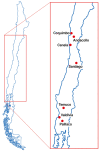Sero-Epidemiology of Pneumocystis Infection among Infants, Children, and Adults in Chile
- PMID: 35205890
- PMCID: PMC8880143
- DOI: 10.3390/jof8020136
Sero-Epidemiology of Pneumocystis Infection among Infants, Children, and Adults in Chile
Abstract
Previous serologic surveys show >80% of infants in Chile have anti-Pneumocystis antibodies by 2 years of age, but the seroepidemiology of Pneumocystis infection beyond infancy is unknown. We describe the sero-epidemiology in infants, children, and adults at different locations in Chile. Serum samples were prospectively obtained from 681 healthy adults (age ≥ 17 years) and 690 non-immunocompromised infants/children attending eight blood banks or outpatient clinics (2 in Santiago) in Chile. ELISA was used to measure serum IgM and IgG antibodies to Pneumocystis jirovecii major surface antigen (Msg) constructs MsgA and MsgC1. Serologic responses to Pneumocystis Msg showed a high frequency of reactivity, inferring infection. Among infants/children increasing age and the proportion with detectable IgM responses to MsgA, and IgG responses to MsgA, and MsgC1 were positively associated. Among adults there was almost universal seropositivity to one or more Pneumocystis Msg constructs. In infants and children rates of detectable IgM responses to MsgC1 and MsgA were greater than IgG responses. In Santiago, rates of seropositivity among infants/children were greater in clinics located in a more socio-economically deprived part of the city. In Chile, a serological response to Pneumocystis Msg constructs was common across ages regardless of geographical location and climatic conditions. Observed higher rates of IgM responses than IgG responses is consistent with concept of recent/ongoing exposure to Pneumocystis in children and adults. Higher rates of seropositivity in infants/children residing in more densely populated areas of Santiago infers crowding poses an increased risk of transmission.
Keywords: Pneumocystis; epidemiology; major surface glycoprotein; serology.
Conflict of interest statement
The authors declare no conflict of interest.
Figures
Similar articles
-
Serologic responses to recombinant Pneumocystis jirovecii major surface glycoprotein among Ugandan patients with respiratory symptoms.PLoS One. 2012;7(12):e51545. doi: 10.1371/journal.pone.0051545. Epub 2012 Dec 21. PLoS One. 2012. PMID: 23284710 Free PMC article.
-
Seroepidemiological study of Pneumocystis jirovecii infection in healthy infants in Chile using recombinant fragments of the P. jirovecii major surface glycoprotein.Int J Infect Dis. 2010 Dec;14(12):e1060-6. doi: 10.1016/j.ijid.2010.07.003. Int J Infect Dis. 2010. PMID: 20926326 Free PMC article.
-
Ambient air pollution associated with suppressed serologic responses to Pneumocystis jirovecii in a prospective cohort of HIV-infected patients with Pneumocystis pneumonia.PLoS One. 2013 Nov 13;8(11):e80795. doi: 10.1371/journal.pone.0080795. eCollection 2013. PLoS One. 2013. PMID: 24236202 Free PMC article.
-
Geographical variation in serological responses to recombinant Pneumocystis jirovecii major surface glycoprotein antigens.Clin Microbiol Infect. 2009 Oct;15(10):937-42. doi: 10.1111/j.1469-0691.2009.02716.x. Epub 2009 Mar 21. Clin Microbiol Infect. 2009. PMID: 19416292 Free PMC article.
-
Pneumocystis jirovecii in Patients With Cystic Fibrosis: A Review.Front Cell Infect Microbiol. 2020 Sep 29;10:571253. doi: 10.3389/fcimb.2020.571253. eCollection 2020. Front Cell Infect Microbiol. 2020. PMID: 33117730 Free PMC article. Review.
Cited by
-
CD4, but not Cxcr6, is necessary for control of Pneumocystis murina infection.Microbes Infect. 2025 Feb;27(2):105408. doi: 10.1016/j.micinf.2024.105408. Epub 2024 Aug 23. Microbes Infect. 2025. PMID: 39182643
-
Role of the Fungus Pneumocystis in IL1β Pathway Activation and Airways Collagen Deposition in Elastase-Induced COPD Animals.Int J Mol Sci. 2024 Mar 9;25(6):3150. doi: 10.3390/ijms25063150. Int J Mol Sci. 2024. PMID: 38542124 Free PMC article.
-
Pneumocystis Exacerbates Inflammation and Mucus Hypersecretion in a Murine, Elastase-Induced-COPD Model.J Fungi (Basel). 2023 Apr 7;9(4):452. doi: 10.3390/jof9040452. J Fungi (Basel). 2023. PMID: 37108906 Free PMC article.
References
-
- Ponce C.A., Chabe M., George C., Cardenas A., Duran L., Guerrero J., Bustamante R., Matos O., Huang L., Miller R.F., et al. High Prevalence of Pneumocystis jirovecii Dihydropteroate Synthase Gene Mutations in Patients with a First Episode of Pneumocystis Pneumonia in Santiago, Chile, and Clinical Response to Trimethoprim-Sulfamethoxazole Therapy. Antimicrob. Agents Chemother. 2017;61:e01290-16. doi: 10.1128/AAC.01290-16. - DOI - PMC - PubMed
Grants and funding
LinkOut - more resources
Full Text Sources


